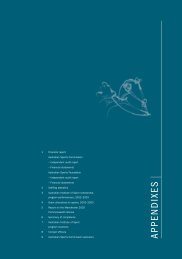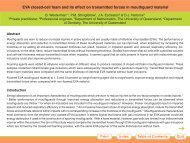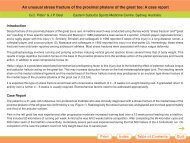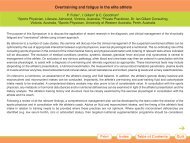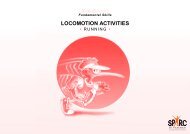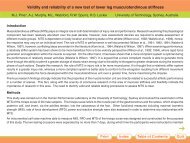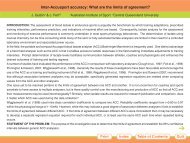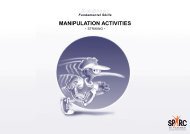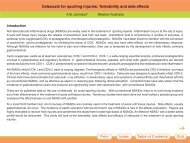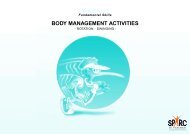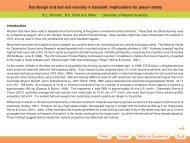Excellence in performance enhancement consulting
Excellence in performance enhancement consulting
Excellence in performance enhancement consulting
Create successful ePaper yourself
Turn your PDF publications into a flip-book with our unique Google optimized e-Paper software.
<strong>Excellence</strong> <strong>in</strong> <strong>performance</strong> <strong>enhancement</strong> consult<strong>in</strong>g<br />
K. Ravizza* California State University at Fullerton<br />
A consult<strong>in</strong>g practice <strong>in</strong>volves both the art and the science of applied sport psychology. I have had the privilege of work<strong>in</strong>g with many elite level<br />
coaches and athletes. In my early years, while many of my colleagues were work<strong>in</strong>g <strong>in</strong> the lab, I made the choice to work on the play<strong>in</strong>g fields<br />
with coaches and athletes and utilize my phenomenological background to study the human experience of coaches and athletes. It is important<br />
to mention that my academic tra<strong>in</strong><strong>in</strong>g was <strong>in</strong> Sport Philosophy with an emphasis <strong>in</strong> existential and phenomenological thought and methods, as<br />
well as Eastern Philosophy, specifically Zen and Hatha Yoga. When I was <strong>in</strong> graduate school, Sport Psychology was just beg<strong>in</strong>n<strong>in</strong>g as a field<br />
and it was primarily a research/motor-learn<strong>in</strong>g field of study.<br />
California State University at Fullerton allowed me the opportunity to expand my perspective and work with student/athletes <strong>in</strong> the area of<br />
Performance Enhancement. My approach has always been grounded <strong>in</strong> existential philosophy and the phenomenological method, and throughout<br />
my career I have worked with both philosophical and psychological skills. I have found that when an athlete knows why she or he is perform<strong>in</strong>g,<br />
it helps the athlete persevere through the difficult periods <strong>in</strong> the journey of excellence (Frankl, 1984). Elite athletes have a love/hate relationship<br />
with their sport. Sport participation can be wonderful and ecstatic, but at times it can truly humble the performer. And this is why the athlete<br />
must know why she or he is perform<strong>in</strong>g so that he or she has a solid foundation to cope with adversity.<br />
Ma<strong>in</strong>ta<strong>in</strong><strong>in</strong>g a balance between the philosophical issues and psychological techniques has always been a part of my work. Sometimes I have<br />
been too quick to “fix” th<strong>in</strong>gs with some technique, i.e. relaxation, imagery, concentration tra<strong>in</strong><strong>in</strong>g, when the real issue is truly the athlete’s<br />
perspective or value that is be<strong>in</strong>g placed on the issue. When the philosophical issues are addressed, it has an impact on so many diverse<br />
levels.<br />
Sport by def<strong>in</strong>ition is an absurd task where the athlete must f<strong>in</strong>d mean<strong>in</strong>g <strong>in</strong> the act of participation. The athlete is required to accept his/her<br />
freedom and make choices and take responsibility for one’s actions. The athlete is a performer who must “stand naked before the gods”, fully<br />
exposed where actions count (Metheny, 1968). It is this dimension of sport that makes it such a powerful experience.<br />
My phenomenological background has helped me value and learn from the coach’s/athlete’s experience. Part of this learn<strong>in</strong>g experience has<br />
been to develop my observational skills so that I am more aware of what is go<strong>in</strong>g on. I have spent countless hours just watch<strong>in</strong>g athletes/<br />
coaches perform <strong>in</strong> practice as well as <strong>in</strong> the competitive arena.<br />
Pr<strong>in</strong>t<br />
Index<br />
Table of Contents<br />
Quit
<strong>Excellence</strong> <strong>in</strong> <strong>performance</strong> <strong>enhancement</strong> consult<strong>in</strong>g<br />
K. Ravizza* California State University at Fullerton<br />
The basic philosophy of my approach is grounded <strong>in</strong> a humanistic, holistic and proactive perspective. I value the <strong>in</strong>dividual’s experience, am<br />
concerned about the total person and I want the athlete to focus on what they have control of. I <strong>in</strong>corporate a collaborative approach by work<strong>in</strong>g<br />
closely with the coach<strong>in</strong>g staff, and I <strong>in</strong>tegrate my <strong>in</strong>formation and skills <strong>in</strong>to exist<strong>in</strong>g protocols. I have also found that a consultant must be<br />
flexible and learn to work <strong>in</strong> a multitude of diverse situations (Ravizza, 2001).<br />
I have found that consult<strong>in</strong>g <strong>in</strong> the area of <strong>performance</strong> <strong>enhancement</strong> has varied depend<strong>in</strong>g upon the context of the situation that I am work<strong>in</strong>g<br />
<strong>in</strong>. I tell athletes that there are no two <strong>performance</strong>s that are the same; there are no two consult<strong>in</strong>g experiences that are the same. Some of<br />
the variables that are go<strong>in</strong>g to alter the experience are the nature of the sport, coach<strong>in</strong>g staff support, access to the athletes, organizational<br />
politics, etc. All of these factors and a multitude of additional factors must be confronted, and dealt with <strong>in</strong> order to develop an effective<br />
program.<br />
Consultation <strong>in</strong>cludes five major tasks, which must be accomplished. They are: ga<strong>in</strong><strong>in</strong>g entry, assessment of the situation, delivery of the<br />
program and program evaluation. The f<strong>in</strong>al aspect that will be addressed are the potential pitfalls that one might confront.<br />
Entry<br />
It is critical to know the sport <strong>in</strong> which you are work<strong>in</strong>g, and the psychological demands that the athletes/coaches must contend with. For<br />
example, team vs. <strong>in</strong>dividual, contact vs. non-contact, objective vs. subjective evaluation, etc. The consultant must also become knowledgeable<br />
of the coach’s orientation, reputation and pressures that he or she must contend with. Credibility and trust must be earned at all levels: from<br />
coaches, to tra<strong>in</strong>ers, to equipment room personnel. When you are an outsider com<strong>in</strong>g <strong>in</strong>to a new culture, some people are go<strong>in</strong>g to be<br />
threatened by you, and for this reason, it is important to form good work<strong>in</strong>g relationships at all levels and clarify the services that you will provide<br />
to the team. I have found the athletic tra<strong>in</strong>ers and/or physical therapists often feel that <strong>performance</strong> <strong>enhancement</strong> consultants are <strong>in</strong>fr<strong>in</strong>g<strong>in</strong>g on<br />
their territory s<strong>in</strong>ce they are the caregivers (Ravizza, 1988; Orlick, 1989; Ogilvie and Henschen, 1995).<br />
At some po<strong>in</strong>t, a presentation will be needed for either the coach<strong>in</strong>g staff and/or the players to expla<strong>in</strong> the program you have developed. This<br />
must be a captivat<strong>in</strong>g, motivat<strong>in</strong>g and stimulat<strong>in</strong>g presentation that truly gets them excited. This is where the consultant needs to speak the<br />
language of the athletes and demonstrate that they have someth<strong>in</strong>g of benefit to ga<strong>in</strong> from gett<strong>in</strong>g <strong>in</strong>volved <strong>in</strong> the program.<br />
Pr<strong>in</strong>t<br />
Index<br />
Table of Contents<br />
Quit
Assessment<br />
<strong>Excellence</strong> <strong>in</strong> <strong>performance</strong> <strong>enhancement</strong> consult<strong>in</strong>g<br />
K. Ravizza* California State University at Fullerton<br />
As a consultant, you must assess the situation and determ<strong>in</strong>e the context of the situation that you will be work<strong>in</strong>g <strong>in</strong>. I want to clarify that by<br />
assessment, I do not mean written psychological assessment, but assessment of the work<strong>in</strong>g situation and the unique sub-culture of that team.<br />
I need to determ<strong>in</strong>e who are the key people that I need to get to support the program, i.e. team leaders, a certa<strong>in</strong> coach, etc. I need to<br />
determ<strong>in</strong>e the support for the program. How much time I will have? How much access I will have to the coaches and players? When and<br />
where will I be giv<strong>in</strong>g presentations to the team?<br />
In this assessment phase, it is critical to be open to verbal and non-verbal feedback and constantly make on-go<strong>in</strong>g adjustments. I also want to<br />
access and establish referral resources and procedures.<br />
Program Delivery<br />
How will the program actually be developed and delivered to the team? Will it be targeted for the coaches and teach<strong>in</strong>g them to do it, or will it<br />
be delivered directly to the players? Will the program be presented <strong>in</strong> a group and/or <strong>in</strong>dividual basis? As a consultant, hopefully you will be<br />
collaborat<strong>in</strong>g closely with the coach<strong>in</strong>g staff <strong>in</strong> the delivery of the program. The key is to figure out the context of the situation that you will be<br />
work<strong>in</strong>g <strong>in</strong> and develop the most effective program for that context. An important part of the delivery is what type of access you will have with<br />
the players. Will you be able to attend practices and games? Will you be able to provide <strong>in</strong>put at practices and games (Poczwardowski, A.,<br />
Sherman, C., Henschen, K.C., 1998).<br />
Program Evaluation<br />
As you go through the consult<strong>in</strong>g process, you will get on-go<strong>in</strong>g feedback on your program. The consultant cannot wait until the end of the<br />
season to evaluate the program, but must constantly assess the situation. Major “red flags” <strong>in</strong>clude: phone calls to the coach are suddenly not<br />
be<strong>in</strong>g returned and/or access to the team is decreas<strong>in</strong>g. The key to program evaluation is that you are work<strong>in</strong>g with enough athletes so that you<br />
are at least mak<strong>in</strong>g a difference with a couple of them. Coaches know that not everyone will be totally supportive of your program, but you need<br />
to work with those who are supportive and not become an irritant and/or distraction to others. The key to program evaluation is that you<br />
determ<strong>in</strong>e <strong>in</strong> collaboration with the coach<strong>in</strong>g staff, the effectiveness of the program and that you are <strong>in</strong>vited back the follow<strong>in</strong>g season.<br />
Pr<strong>in</strong>t<br />
Index<br />
Table of Contents<br />
Quit
<strong>Excellence</strong> <strong>in</strong> <strong>performance</strong> <strong>enhancement</strong> consult<strong>in</strong>g<br />
K. Ravizza* California State University at Fullerton<br />
Potential Pitfalls<br />
The biggest issue for me is the “shr<strong>in</strong>k image”, I am not a psychologist, but the stereotype is difficult to overcome. ”“I am okay, Doc.” I hear this<br />
so often when the athletes aren’t clear what it is that I do. I keep tell<strong>in</strong>g them my approach is proactive; it is about what it takes to be great. It<br />
is not a reactive approach where the athlete is “messed” up and I am go<strong>in</strong>g to fix him/her.<br />
Another pitfall is not understand<strong>in</strong>g the sport and unique demands with which the athlete must contend. Closely associated with this is<br />
<strong>in</strong>adequate knowledge of the politics of the situation. This is especially critical with Olympic and Professional sports (Woodman, T. & Hardy, L.,<br />
2001).<br />
Be careful not to take a research and/or theoretical orientation with elite athletes. In all my years of consult<strong>in</strong>g, I have never been asked to<br />
show any coaches my publications; they only want to know with whom I have worked. One f<strong>in</strong>al po<strong>in</strong>t is be careful to ma<strong>in</strong>ta<strong>in</strong> patience <strong>in</strong><br />
deliver<strong>in</strong>g the program. If you come on too strong, you are go<strong>in</strong>g to turn people off. So the consultant has to f<strong>in</strong>d that delicate balance between<br />
be<strong>in</strong>g assertive and patient <strong>in</strong> provid<strong>in</strong>g assistance.<br />
In summary, every consult<strong>in</strong>g experience is unique and one must assess the unique context of the particular situation and learn the delicate<br />
balance or act of design<strong>in</strong>g and deliver<strong>in</strong>g an effective program to effectively meet the needs of that unique situation.<br />
References<br />
Frankl, V. (1984). Man’s Search for Mean<strong>in</strong>g. N.Y.: Touchstone Books.<br />
Metheny, E. (1968). Movement & Mean<strong>in</strong>g. N.Y.: McGraw-Hill.<br />
Orlick, T (1989). Reflections on sport psychology consult<strong>in</strong>g with <strong>in</strong>dividual and team sport athletes at the Summer and W<strong>in</strong>ter Olympic Games.<br />
The Sport Psychologist, 3, 358-365.<br />
Ravizza, K. (1988). Ga<strong>in</strong><strong>in</strong>g entry with athlete personnel for season long consult<strong>in</strong>g. The Sport Psychologist, 2, 243-254.<br />
Olgilvie, B. & Henschen, K. (1995). The art of application of psychological enhanc<strong>in</strong>g pr<strong>in</strong>ciples. In. K.P. Henschen & W.F. Straub, (Eds.), Sport<br />
Psychology: An Analysis of Athlete Behavior. (2 nd ed., pp. 45-54). Longmeadow, MA: Movement Publications.<br />
Poczwardowski, A., Sherman, C. & Henschen, K. (1998). A Sport Psychology Service Delivery Heuristic Build<strong>in</strong>g on Theory & Practice. The<br />
Sport Psychologist, 12, 192-208.<br />
Woodman, T. & Hardy, L. (2001). A Case Study of Organizational Stress <strong>in</strong> Elite Sport. Journal of Applied Sport Psychology,<br />
13, 207-238.<br />
Pr<strong>in</strong>t<br />
Index<br />
Table of Contents<br />
Quit
<strong>Excellence</strong> <strong>in</strong> <strong>performance</strong> <strong>enhancement</strong> consult<strong>in</strong>g<br />
K. Ravizza*<br />
California State University at Fullerton<br />
A consult<strong>in</strong>g practice <strong>in</strong>volves both the art and the science of applied sport psychology. I have had the privilege of work<strong>in</strong>g<br />
with many elite level coaches and athletes. In my early years, while many of my colleagues were work<strong>in</strong>g <strong>in</strong> the lab, I made the<br />
choice to work on the play<strong>in</strong>g fields with coaches and athletes and utilize my phenomenological background to study the human<br />
experience of coaches and athletes. It is important to mention that my academic tra<strong>in</strong><strong>in</strong>g was <strong>in</strong> Sport Philosophy with an<br />
emphasis <strong>in</strong> existential and phenomenological thought and methods, as well as Eastern Philosophy, specifically Zen and Hatha<br />
Yoga. When I was <strong>in</strong> graduate school, Sport Psychology was just beg<strong>in</strong>n<strong>in</strong>g as a field and it was primarily a research/motorlearn<strong>in</strong>g<br />
field of study.<br />
California State University at Fullerton allowed me the opportunity to expand my perspective and work with<br />
student/athletes <strong>in</strong> the area of Performance Enhancement. My approach has always been grounded <strong>in</strong> existential philosophy<br />
and the phenomenological method, and throughout my career I have worked with both philosophical and psychological skills. I<br />
have found that when an athlete knows why she or he is perform<strong>in</strong>g, it helps the athlete persevere through the difficult periods <strong>in</strong><br />
the journey of excellence (Frankl, 1984). Elite athletes have a love/hate relationship with their sport. Sport participation can be<br />
wonderful and ecstatic, but at times it can truly humble the performer. And this is why the athlete must know why she or he is<br />
perform<strong>in</strong>g so that he or she has a solid foundation to cope with adversity.<br />
Ma<strong>in</strong>ta<strong>in</strong><strong>in</strong>g a balance between the philosophical issues and psychological techniques has always been a part of my<br />
work. Sometimes I have been too quick to “fix” th<strong>in</strong>gs with some technique, i.e. relaxation, imagery, concentration tra<strong>in</strong><strong>in</strong>g, when<br />
the real issue is truly the athlete’s perspective or value that is be<strong>in</strong>g placed on the issue. When the philosophical issues are<br />
addressed, it has an impact on so many diverse levels.<br />
Sport by def<strong>in</strong>ition is an absurd task where the athlete must f<strong>in</strong>d mean<strong>in</strong>g <strong>in</strong> the act of participation. The athlete is<br />
required to accept his/her freedom and make choices and take responsibility for one’s actions. The athlete is a performer who<br />
must “stand naked before the gods”, fully exposed where actions count (Metheny, 1968). It is this dimension of sport that makes<br />
it such a powerful experience.<br />
My phenomenological background has helped me value and learn from the coach’s/athlete’s experience. Part of this<br />
learn<strong>in</strong>g experience has been to develop my observational skills so that I am more aware of what is go<strong>in</strong>g on. I have spent<br />
countless hours just watch<strong>in</strong>g athletes/coaches perform <strong>in</strong> practice as well as <strong>in</strong> the competitive arena.<br />
The basic philosophy of my approach is grounded <strong>in</strong> a humanistic, holistic and proactive perspective. I value the<br />
<strong>in</strong>dividual's experience, am concerned about the total person and I want the athlete to focus on what they have control of. I<br />
<strong>in</strong>corporate a collaborative approach by work<strong>in</strong>g closely with the coach<strong>in</strong>g staff, and I <strong>in</strong>tegrate my <strong>in</strong>formation and skills <strong>in</strong>to<br />
exist<strong>in</strong>g protocols. I have also found that a consultant must be flexible and learn to work <strong>in</strong> a multitude of diverse situations<br />
(Ravizza, 2001).<br />
I have found that consult<strong>in</strong>g <strong>in</strong> the area of <strong>performance</strong> <strong>enhancement</strong> has varied depend<strong>in</strong>g upon the context of the situation<br />
that I am work<strong>in</strong>g <strong>in</strong>. I tell athletes that there are no two <strong>performance</strong>s that are the same; there are no two consult<strong>in</strong>g<br />
experiences that are the same. Some of the variables that are go<strong>in</strong>g to alter the experience are the nature of the sport, coach<strong>in</strong>g<br />
staff support, access to the athletes, organizational politics, etc. All of these factors and a multitude of additional factors must be<br />
confronted, and dealt with <strong>in</strong> order to develop an effective program.<br />
Consultation <strong>in</strong>cludes five major tasks, which must be accomplished. They are: ga<strong>in</strong><strong>in</strong>g entry, assessment of the<br />
situation, delivery of the program and program evaluation. The f<strong>in</strong>al aspect that will be addressed are the potential pitfalls that<br />
one might confront.<br />
ENTRY: It is critical to know the sport <strong>in</strong> which you are work<strong>in</strong>g, and the psychological demands that the athletes/coaches<br />
must contend with. For example, team vs. <strong>in</strong>dividual, contact vs. non-contact, objective vs. subjective evaluation, etc. The<br />
consultant must also become knowledgeable of the coach’s orientation, reputation and pressures that he or she must contend<br />
with. Credibility and trust must be earned at all levels: from coaches, to tra<strong>in</strong>ers, to equipment room personnel. When you are<br />
an outsider com<strong>in</strong>g <strong>in</strong>to a new culture, some people are go<strong>in</strong>g to be threatened by you, and for this reason, it is important to form<br />
good work<strong>in</strong>g relationships at all levels and clarify the services that you will provide to the team. I have found the athletic tra<strong>in</strong>ers<br />
and/or physical therapists often feel that <strong>performance</strong> <strong>enhancement</strong> consultants are <strong>in</strong>fr<strong>in</strong>g<strong>in</strong>g on their territory s<strong>in</strong>ce they are the<br />
caregivers (Ravizza, 1988; Orlick, 1989; Ogilvie and Henschen, 1995).<br />
At some po<strong>in</strong>t, a presentation will be needed for either the coach<strong>in</strong>g staff and/or the players to expla<strong>in</strong> the program you<br />
have developed. This must be a captivat<strong>in</strong>g, motivat<strong>in</strong>g and stimulat<strong>in</strong>g presentation that truly gets them excited. This is where<br />
the consultant needs to speak the language of the athletes and demonstrate that they have someth<strong>in</strong>g of benefit to ga<strong>in</strong> from<br />
gett<strong>in</strong>g <strong>in</strong>volved <strong>in</strong> the program.<br />
1
ASSESSMENT: As a consultant, you must assess the situation and determ<strong>in</strong>e the context of the situation that you will be<br />
work<strong>in</strong>g <strong>in</strong>. I want to clarify that by assessment, I do not mean written psychological assessment, but assessment of the work<strong>in</strong>g<br />
situation and the unique sub-culture of that team. I need to determ<strong>in</strong>e who are the key people that I need to get to support the<br />
program, i.e. team leaders, a certa<strong>in</strong> coach, etc. I need to determ<strong>in</strong>e the support for the program. How much time I will have?<br />
How much access I will have to the coaches and players? When and where will I be giv<strong>in</strong>g presentations to the team?<br />
In this assessment phase, it is critical to be open to verbal and non-verbal feedback and constantly make on-go<strong>in</strong>g<br />
adjustments. I also want to access and establish referral resources and procedures.<br />
PROGRAM DELIVERY: How will the program actually be developed and delivered to the team? Will it be targeted for the<br />
coaches and teach<strong>in</strong>g them to do it, or will it be delivered directly to the players? Will the program be presented <strong>in</strong> a group<br />
and/or <strong>in</strong>dividual basis? As a consultant, hopefully you will be collaborat<strong>in</strong>g closely with the coach<strong>in</strong>g staff <strong>in</strong> the delivery of the<br />
program. The key is to figure out the context of the situation that you will be work<strong>in</strong>g <strong>in</strong> and develop the most effective program<br />
for that context. An important part of the delivery is what type of access you will have with the players. Will you be able to attend<br />
practices and games? Will you be able to provide <strong>in</strong>put at practices and games (Poczwardowski, A., Sherman, C., Henschen,<br />
K.C., 1998).<br />
PROGRAM EVALUTION: As you go through the consult<strong>in</strong>g process, you will get on-go<strong>in</strong>g feedback on your program. The<br />
consultant cannot wait until the end of the season to evaluate the program, but must constantly assess the situation. Major "red<br />
flags" <strong>in</strong>clude: phone calls to the coach are suddenly not be<strong>in</strong>g returned and/or access to the team is decreas<strong>in</strong>g. The key to<br />
program evaluation is that you are work<strong>in</strong>g with enough athletes so that you are at least mak<strong>in</strong>g a difference with a couple of<br />
them. Coaches know that not everyone will be totally supportive of your program, but you need to work with those who are<br />
supportive and not become an irritant and/or distraction to others. The key to program evaluation is that you determ<strong>in</strong>e <strong>in</strong><br />
collaboration with the coach<strong>in</strong>g staff, the effectiveness of the program and that you are <strong>in</strong>vited back the follow<strong>in</strong>g season.<br />
POTENTIAL PITFALLS: The biggest issue for me is the “shr<strong>in</strong>k image”, I am not a psychologist, but the stereotype is difficult<br />
to overcome. “I am okay, Doc.” I hear this so often when the athletes aren’t clear what it is that I do. I keep tell<strong>in</strong>g them my<br />
approach is proactive; it is about what it takes to be great. It is not a reactive approach where the athlete is "messed" up and I<br />
am go<strong>in</strong>g to fix him/her.<br />
Another pitfall is not understand<strong>in</strong>g the sport and unique demands with which the athlete must contend. Closely associated<br />
with this is <strong>in</strong>adequate knowledge of the politics of the situation. This is especially critical with Olympic and Professional sports<br />
(Woodman, T. & Hardy, L., 2001).<br />
Be careful not to take a research and/or theoretical orientation with elite athletes. In all my years of consult<strong>in</strong>g, I have<br />
never been asked to show any coaches my publications; they only want to know with whom I have worked. One f<strong>in</strong>al po<strong>in</strong>t is be<br />
careful to ma<strong>in</strong>ta<strong>in</strong> patience <strong>in</strong> deliver<strong>in</strong>g the program. If you come on too strong, you are go<strong>in</strong>g to turn people off. So the<br />
consultant has to f<strong>in</strong>d that delicate balance between be<strong>in</strong>g assertive and patient <strong>in</strong> provid<strong>in</strong>g assistance.<br />
In summary, every consult<strong>in</strong>g experience is unique and one must assess the unique context of the particular situation<br />
and learn the delicate balance or act of design<strong>in</strong>g and deliver<strong>in</strong>g an effective program to effectively meet the needs of that unique<br />
situation.<br />
REFERENCES:<br />
1. Frankl, V. (1984). Man's Search for Mean<strong>in</strong>g. N.Y.: Touchstone Books.<br />
2. Metheny, E. (1968). Movement & Mean<strong>in</strong>g. N.Y.: McGraw-Hill.<br />
3. Orlick, T (1989). Reflections on sport psychology consult<strong>in</strong>g with <strong>in</strong>dividual and team sport athletes at the Summer and<br />
W<strong>in</strong>ter Olympic Games. The Sport Psychologist, 3, 358-365.<br />
4. Ravizza, K. (1988). Ga<strong>in</strong><strong>in</strong>g entry with athlete personnel for season long consult<strong>in</strong>g. The Sport Psychologist, 2, 243-254.<br />
5. Olgilvie, B. & Henschen, K. (1995). The art of application of psychological enhanc<strong>in</strong>g pr<strong>in</strong>ciples. In. K.P. Henschen &<br />
W.F. Straub, (Eds.), Sport Psychology: An Analysis of Athlete Behavior. (2 nd ed., pp. 45-54). Longmeadow, MA:<br />
Movement Publications.<br />
6. Poczwardowski, A., Sherman, C. & Henschen, K. (1998). A Sport Psychology Service Delivery Heuristic Build<strong>in</strong>g on<br />
Theory & Practice. The Sport Psychologist, 12, 192-208.<br />
7. Woodman, T. & Hardy, L. (2001). A Case Study of Organizational Stress <strong>in</strong> Elite Sport. Journal of Applied Sport<br />
Psychology, 13, 207-238.<br />
2



